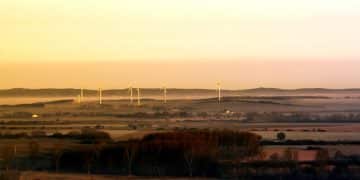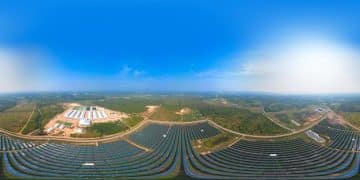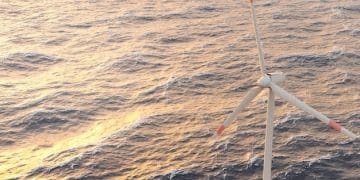Offshore Wind Farms: Reshaping the US Energy Landscape by 2035
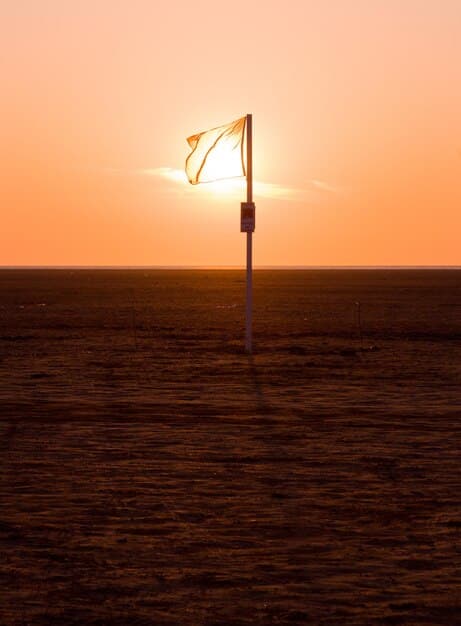
By 2035, the development of offshore wind farms is projected to significantly transform the US energy landscape by diversifying energy sources, creating numerous jobs, and reducing dependence on fossil fuels, contributing to a greener and more sustainable energy future.
The development of offshore wind farms is poised to revolutionize the US energy landscape. But how exactly will these massive projects impact the way Americans source and consume energy by 2035? Let’s dive into the future of wind power off our shores.
The Current State of US Offshore Wind Energy
Offshore wind energy in the US is still in its early stages, but it’s rapidly gaining momentum. Understanding the current landscape is essential to projecting its future impact.
While Europe has been harnessing offshore wind for decades, the US is just beginning to tap into this vast energy resource. Several projects are currently in development along the East Coast, with ambitious goals for future expansion.
Existing Offshore Wind Projects
The first commercial offshore wind farm in the US, the Block Island Wind Farm, began operating off the coast of Rhode Island in 2016. Although small, it paved the way for larger projects.
Planned Developments and Investments
Numerous larger-scale projects are planned, with significant investments being made in states like Massachusetts, New York, and New Jersey. These projects aim to bring clean energy to densely populated coastal areas.
- Vineyard Wind (Massachusetts): One of the first large-scale projects, promising significant power generation.
- Empire Wind (New York): Aiming to power over a million homes in New York City.
- Ocean Wind (New Jersey): Expected to become a major energy source for the state.
These projects represent substantial investments in renewable energy infrastructure, promising to change how the US generates electricity.
In summary, while still nascent, the US offshore wind sector is on the cusp of major growth, driven by increasing investments and ambitious development plans.
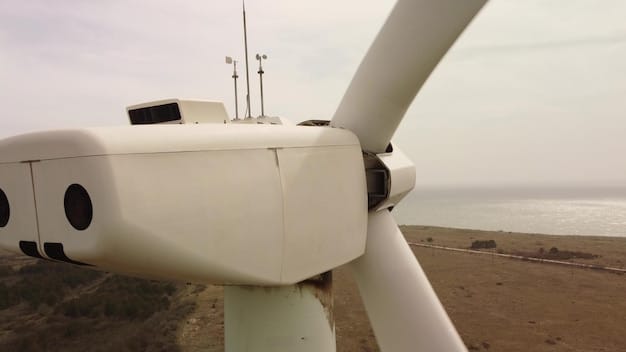
Projected Growth of Offshore Wind Capacity by 2035
Forecasting the expansion of offshore wind capacity requires considering various factors, from technological advancements to policy decisions.
By 2035, the US is expected to see a substantial increase in offshore wind capacity. Projections vary, but most suggest a multi-gigawatt expansion, significantly contributing to the nation’s renewable energy portfolio.
Factors Influencing Growth
Several factors will influence the growth rate of offshore wind capacity, including technological improvements, policy support, and the development of necessary infrastructure.
Expected Capacity Additions
Industry analysts predict that the US could have between 20 to 40 gigawatts of offshore wind capacity installed by 2035. This addition would represent a significant leap from current levels.
Impact of Government Policies and Incentives
Government policies, such as tax credits and renewable energy standards, are crucial in driving investment and development in the offshore wind sector.
- Investment Tax Credits: Provide financial incentives for developers.
- Renewable Portfolio Standards: Mandate that utilities source a certain percentage of their electricity from renewable sources.
- Federal Leasing Programs: Enable the development of wind farms in federal waters.
These policies create a favorable environment for offshore wind development, encouraging investment and accelerating growth.
Overall, the projected growth of offshore wind capacity by 2035 is substantial, driven by technological advancements, supportive policies, and increasing demand for renewable energy.
Impact on the US Energy Mix
The addition of significant offshore wind capacity will undoubtedly impact the composition of the US energy mix, affecting both renewable and traditional energy sources.
As offshore wind farms come online, they will contribute a larger share of the nation’s electricity generation, reducing dependence on fossil fuels and diversifying the energy supply.
Reduction in Fossil Fuel Dependence
One of the primary benefits of increased offshore wind capacity is the potential to reduce reliance on fossil fuels such as coal and natural gas.
Contribution to Renewable Energy Goals
Offshore wind can play a major role in helping states and the nation meet their renewable energy goals, contributing to a cleaner and more sustainable energy system.
Changes in Energy Sources
With the increase in wind energy production, there will be significant changes how the energy is distributed.
- Increased investment in distribution and transmission
- Smart grid technologies
- Changes in coal output.
These changes are essential for integrating offshore wind energy into the grid seamlessly.
In conclusion, the impact on the US energy mix by 2035 will be substantial, with offshore wind playing a crucial role in reducing fossil fuel dependence and advancing renewable energy goals.

Economic Benefits and Job Creation
The development of offshore wind farms offers significant economic benefits and job creation opportunities across various sectors.
Investing in offshore wind energy can stimulate economic growth, create new jobs, and support local industries. These benefits extend beyond the energy sector, positively impacting coastal communities and the national economy.
Direct and Indirect Job Creation
Offshore wind projects create jobs in manufacturing, construction, installation, maintenance, and operation. In addition, they support indirect jobs in related industries.
Investment in Infrastructure
The development of offshore wind farms requires significant investment in infrastructure, including ports, transmission lines, and manufacturing facilities. This investment can boost local economies and create long-term employment opportunities.
Impact on Local Communities
Coastal communities stand to benefit from offshore wind development through increased tax revenues, job creation, and support for local businesses. However, careful planning is needed to minimize potential negative impacts on fishing and tourism.
Overall, the economic benefits and job creation potential of offshore wind energy are substantial, providing a significant boost to the US economy while supporting the transition to a cleaner energy future.
Challenges and Obstacles
Despite the immense potential of offshore wind energy, several challenges and obstacles must be addressed to ensure its successful development.
From technological hurdles to regulatory complexities, the path to widespread offshore wind adoption is not without its difficulties. Overcoming these challenges will be crucial for realizing the full potential of this renewable energy source.
Technological Hurdles
Developing and deploying offshore wind technology requires overcoming several technical challenges, including turbine design, grid integration, and deepwater engineering.
Environmental Concerns
The construction and operation of offshore wind farms can have environmental impacts on marine ecosystems and wildlife. Careful planning and mitigation measures are needed to minimize these impacts.
Regulatory and Permitting Processes
Navigating the complex regulatory and permitting processes can be time-consuming and costly for offshore wind developers. Streamlining these processes is essential for accelerating project development.
- The National Environmental Policy Act (NEPA)
- Endangered Species Act (ESA)
- Marine Mammal Protection Act (MMPA)
Addressing these challenges will be critical for unlocking the full potential of offshore wind energy in the US.
In conclusion, addressing these challenges is vital for realizing the full potential of offshore wind energy, ensuring its sustainable and successful integration into the US energy landscape.
Future Innovations and Technological Advancements
The future of offshore wind energy is likely to be shaped by ongoing innovations and technological advancements that improve efficiency, reduce costs, and enhance environmental performance.
As technology continues to evolve, offshore wind farms will become more efficient, reliable, and cost-effective. These advancements will drive further expansion and accelerate the transition to a cleaner energy future.
Larger and More Efficient Turbines
The development of larger and more efficient turbines, with higher capacity factors, is expected to increase electricity generation and reduce the levelized cost of energy.
Floating Wind Technology
Floating wind technology, which allows turbines to be deployed in deeper waters, can unlock new areas for offshore wind development, expanding the resource potential.
Advanced Grid Integration Techniques
Innovations in grid integration techniques, such as high-voltage direct current (HVDC) transmission, can improve the efficiency and reliability of transmitting electricity from offshore wind farms to onshore grids.
These future innovations will play a crucial role in making offshore wind energy an even more competitive and sustainable energy source.
In summary, ongoing innovations and technological advancements hold the key to unlocking the full potential of offshore wind energy, making it a central component of a cleaner and more sustainable energy future.
| Key Point | Brief Description |
|---|---|
| ⚡ Growth by 2035 | Expected capacity additions between 20 to 40 gigawatts. |
| 💼 Economic Impact | Job creation in manufacturing, construction, and maintenance. |
| 🌍 Renewable Goals | Contribution to reducing fossil fuel dependence and meeting renewable targets. |
| ⚙️ Future Tech | Larger turbines and floating wind tech for deeper waters. |
Frequently Asked Questions
▼
Experts predict that USA offshore wind capacity could between 20 to 40 gigatonnes by 2035, dependent on investments, regulation and demand.
▼
Though mostly positive, there are potential negative impacts, like effects on marine creatures and habitats. Careful planning is vital to reduce these.
▼
Offshore wind projects are able to create numerous direct and indirect positions, mainly in manufacturing, construction, maintenance, and operations.
▼
Government incentives like Renewable Portfolio Standards (RPS) and investment tax credits help growth by attracting investment and demand.
▼
The wind farms will depend mostly in larger & more efficient turbines and floating wind turbine tech, it’ll improve electricity production and allow them to build them in deep waters.
Conclusion
The growth of offshore wind farms promises to reshape the US energy landscape by 2035. As capacity expands, the nation will see a reduced dependence on fossil fuels, significant job creation, and advancements in renewable energy technologies. While challenges remain, the potential benefits make offshore wind a critical component of a sustainable energy future for the United States.



